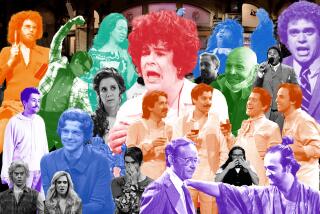On the Media: Photojournalism’s visceral power clear at the Getty
Sadness, revulsion, pride, anger and compassion are sure to follow. But an initial look at James Nachtwey’s massive photo collage from military field hospitals in Iraq first provokes simple curiosity.
Could that charred nub really be a human nose? What part of pale flesh is that hidden beneath a knot of plastic surgical tube? Is that doctor’s slippery, gloved finger really probing inside someone’s skull?
“The Sacrifice” is the powerful centerpiece of a new exhibition at the J. Paul Getty Museum that celebrates the ability of still images to seize and command our attention, even in an era when digital video streams scream at us 24 hours a day.
When the Nachtwey piece debuted three years ago at a New York City gallery, it overwhelmed one ex-Marine. He suggested the installation — 60 operating room photos, stacked three high, 20 wide, stretching about 30 feet — be displayed on Times Square’s gigantic billboards.
There’s something about the mass of images that conveys the cost of a war that is too easily out of sight and out of mind. A showing in Times Square wouldn’t be a bad start. Then how about loading “The Sacrifice” on a flatbed truck and taking it to town squares around America?
With newspapers and magazines in retreat and websites typically offering mostly a more scattered and diffuse audience, venues for visceral, unflinching photojournalism have been diminished.
Nachtwey, one of the world’s most renowned crisis photographers, said that he could spend time obsessing over what becomes of the work. But he’s too busy making sure the work gets done.
The survivor of numerous scrapes over more than three decades in the business, seriously injured in a 2003 grenade attack on a Humvee he rode during the early days of the Iraq war, he plans to return this year to document the war in Afghanistan.
“There is no point in worrying about what happens next in the business,” Nachtwey said during the Monday night opening of the exhibit, “Engaged Observers: Documentary Photography Since the Sixties.” “You just move on, keep moving and finding new ways to keep doing what you are doing.
“I think we will always need to be informed about what is happening in the world,” he added. “And still photography is one of the most powerful ways to get this across. That won’t change. As long as there is a need for this kind of work, there has to be a way to support it. There has to be.”
I’ve written before about how difficult logistics, editorial inconsistency, shrinking print space and the far-flung nature of America’s two wars have conspired so that most of us see little of the most dire consequences of the fighting.
But that hasn’t stopped a determined group of photographers from trying to show what is happening in Iraq and Afghanistan, both to U.S. troops and to the native populations.
Chris Hondros, the photographer who in 2005 captured the haunting images of Iraqi children who saw their parents shot by U.S. troops, said plenty of important pictures are still being taken in the world’s hot spots.
“What is lacking, perhaps, is the path to having that work seen widely in a fragmenting media landscape, and fair compensation for that work,” Hondros said in an e-mail from Afghanistan, where he is on assignment.
One excellent photographer from the conflicts in the Mideast, Stefan Zaklin, left his old career and got an MBA, partly because he was not certain he could support a budding family, given journalism’s shaky moorings. He starts in a couple of weeks with John Deere, the farm equipment maker.
Zaklin also worries about how his old compatriots will find an audience for their work — noting the irony that the greatest vehicle for information distribution in history hasn’t provided a clear solution.
“In 1998 or ’99 we thought the Internet would be the answer,” said Zaklin, 36. “We wouldn’t need print. We could reach people in our own way on the Web. What we failed to take into account was the massive amount of work on the Internet and how people would be able to find our work.”
Veterans Nachtwey and Hondros have a certain faith that the photographic record is so essential that the economics and delivery systems will work themselves out.
The select few will have the chance to see Nachtwey’s work at the new exhibit, on display through Nov. 14 at the Getty Center, along with the work of nine other documentary photographers. Work dating from the 1960s covers the gamut of humanity living on an assortment of frontiers, with Leonard Freed’s “Black in White America,” Mary Ellen Mark’s “Streetwise” teens of Seattle, Sebastiao Salgado’s take on the world’s migrant poor, and more.
The Nachtwey montage makes up the literal and figurative center of the exhibit — filling a wall with pictures made during a couple of months at American field hospitals in Iraq. The photographer suffered similar trauma care after the 2003 attack, in which his Time magazine colleague, Michael Weisskopf, lost his hand tossing the grenade out of their Humvee.
It’s individual pictures — a soldier’s desperate eyes, a chaplain’s compassionate touch, hands gently plucking heart monitors from a lifeless torso — that seize our attention. The dozens of images pressed together — with space, borders, breathing room — convey the enormity of the suffering and the sense that the losses have not ended.
Nachtwey told me that, far from becoming numb after recording years of suffering on multiple continents, he remains “very sensitized.” At 62, he shows no sign of backing off. When American forces advance this year with their offensive in Kandahar, Nachtwey plans to be among them.
“I have been a witness, and these pictures are my testimony,” the photographer writes on his website. The events I have recorded should not be forgotten and must not be repeated.”
Twitter:latimesrainey
More to Read
The biggest entertainment stories
Get our big stories about Hollywood, film, television, music, arts, culture and more right in your inbox as soon as they publish.
You may occasionally receive promotional content from the Los Angeles Times.











